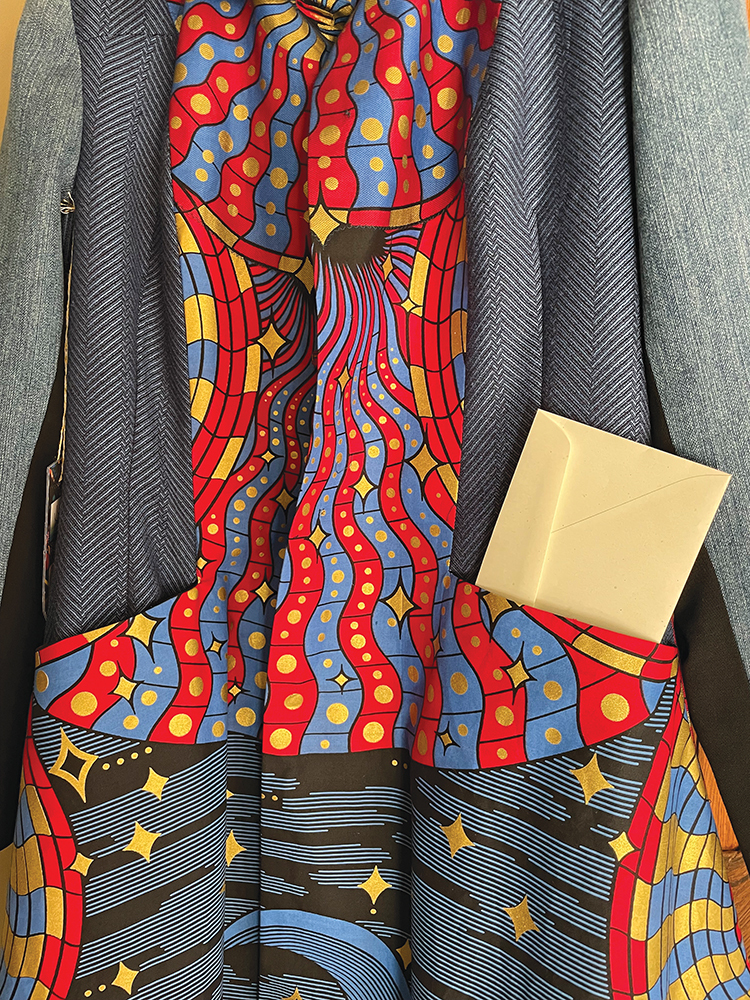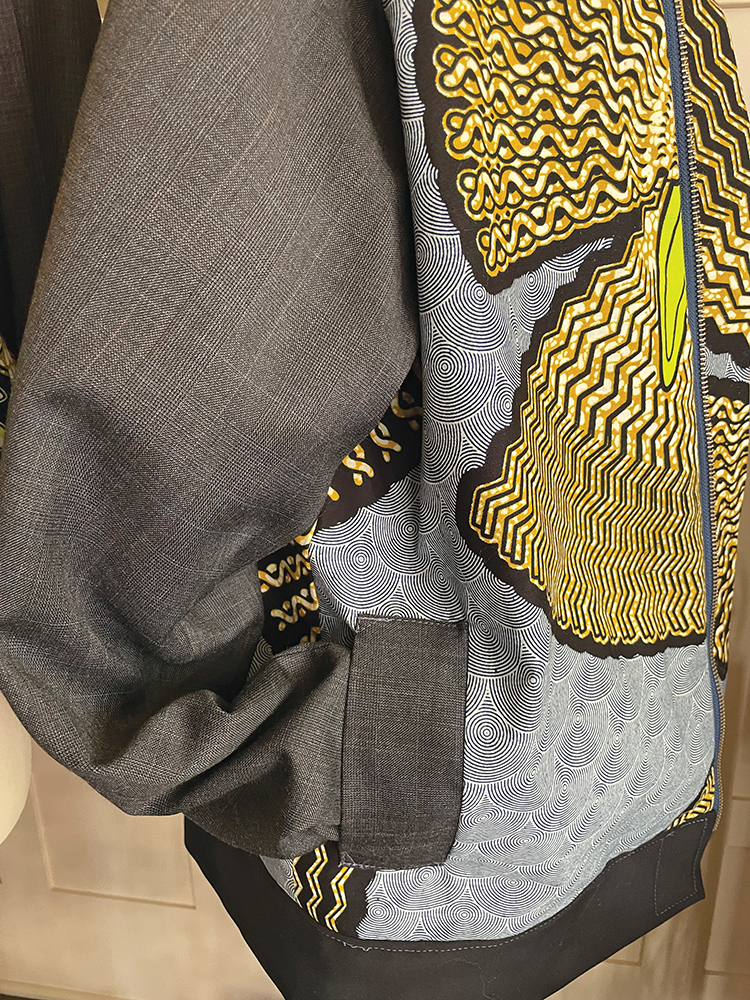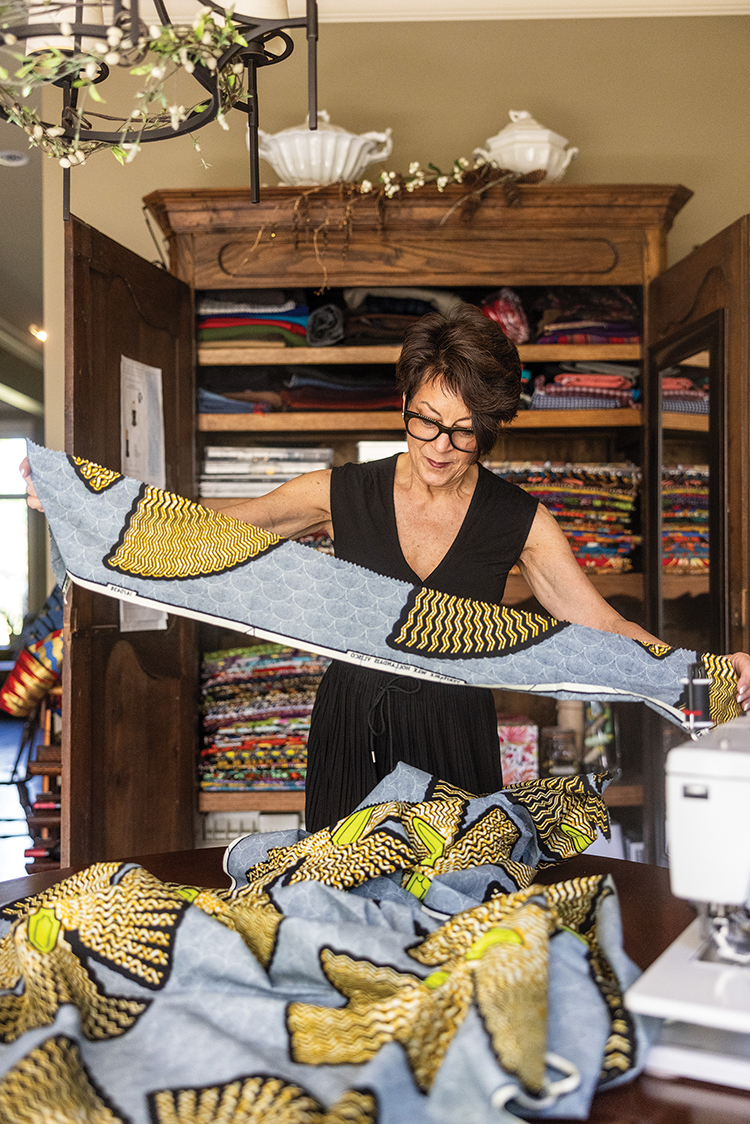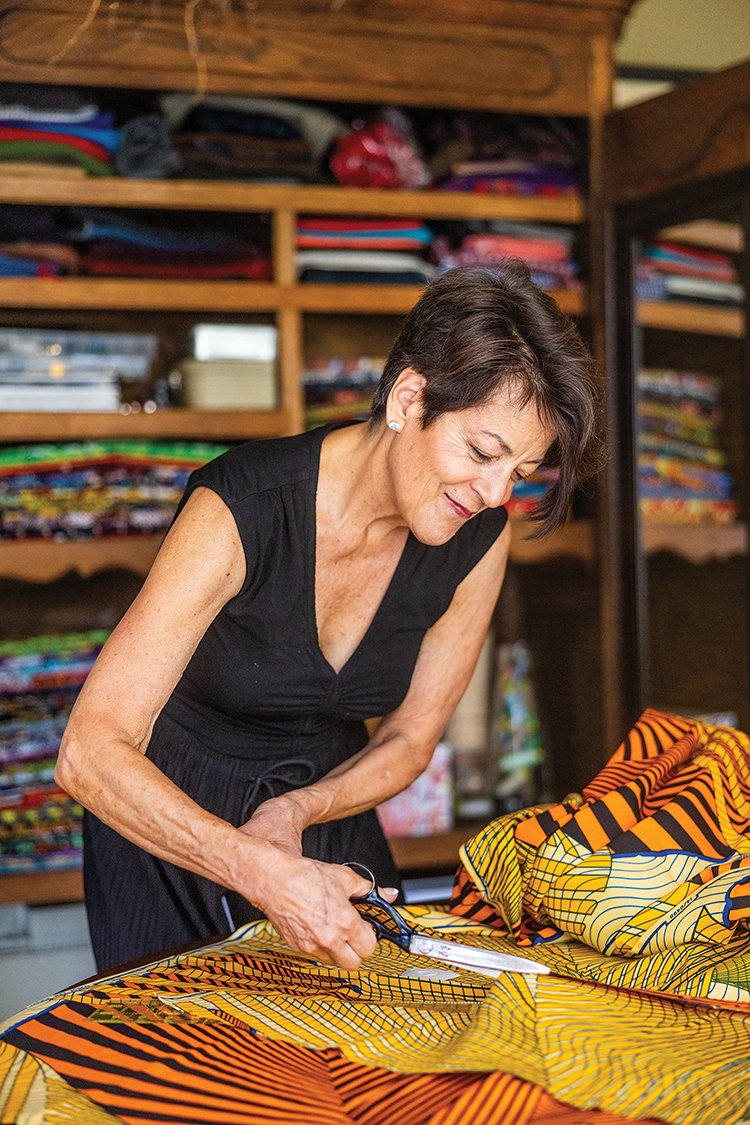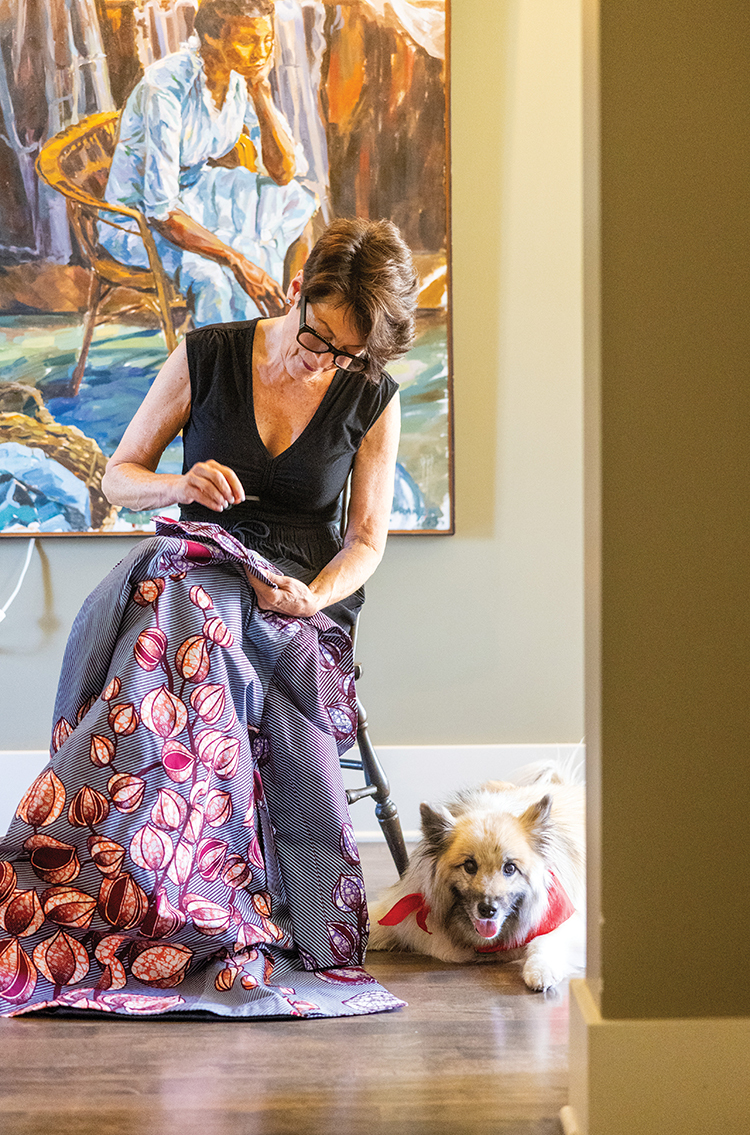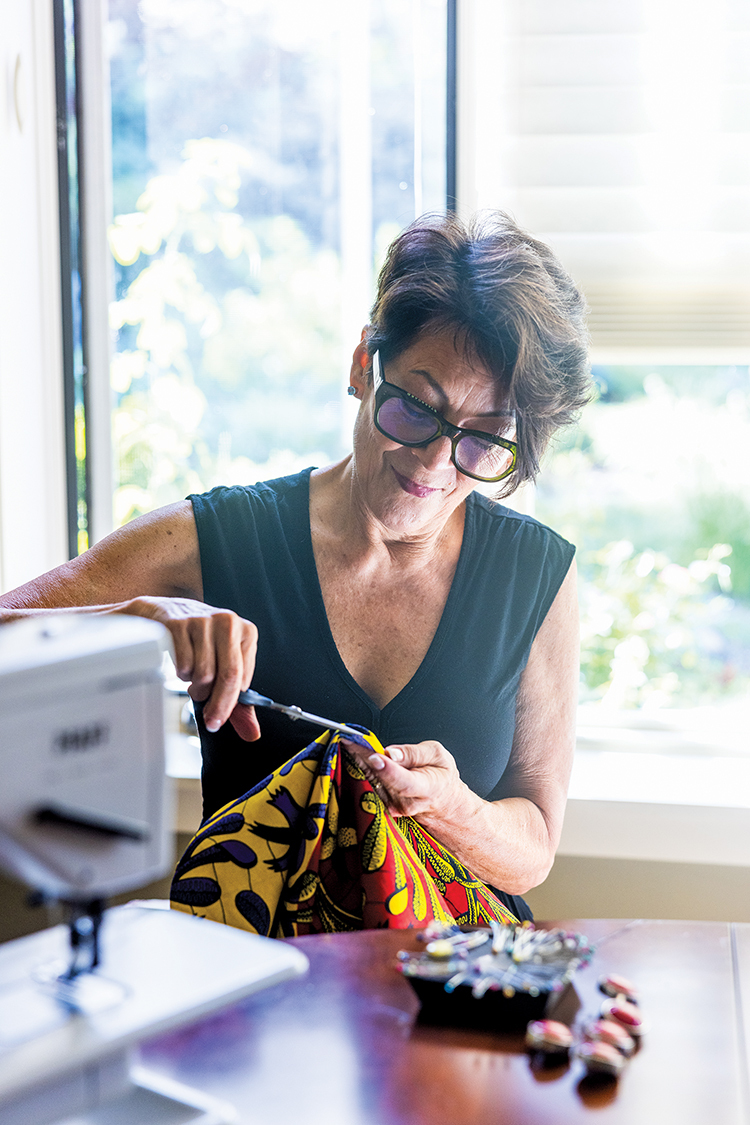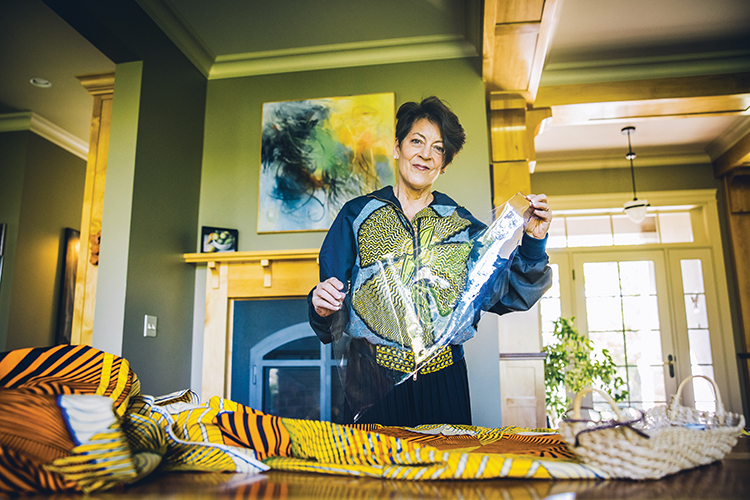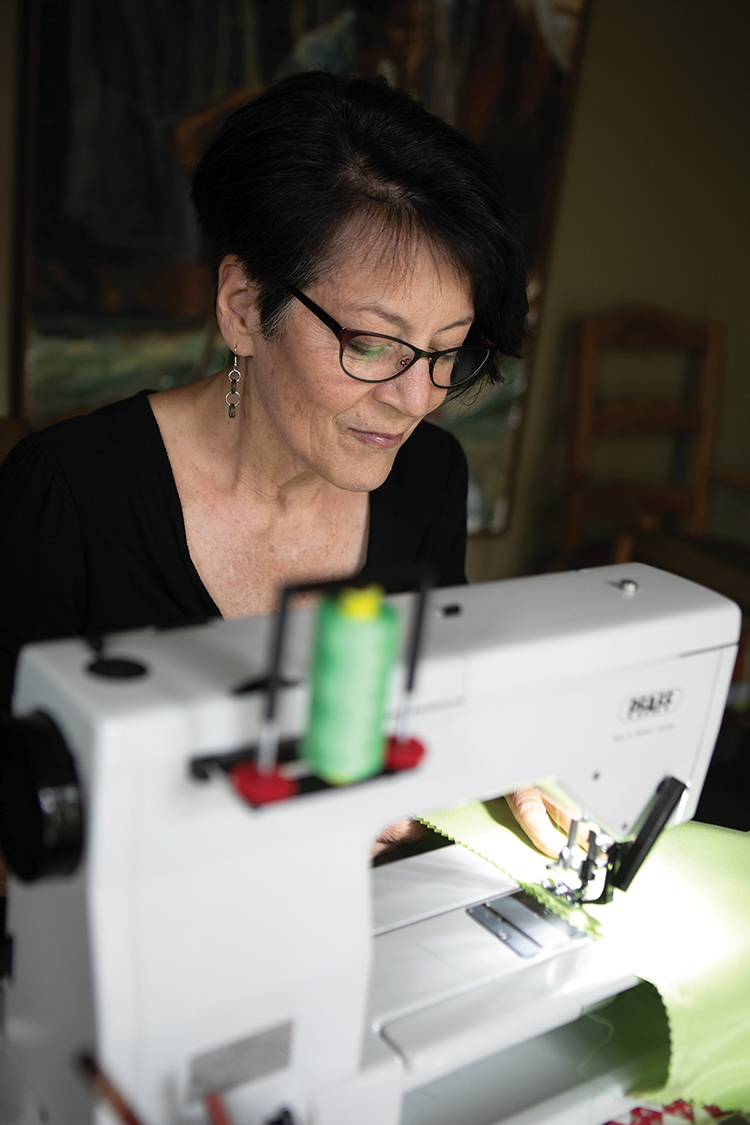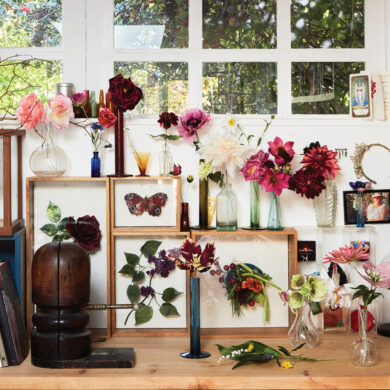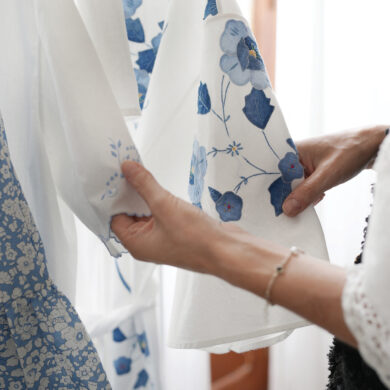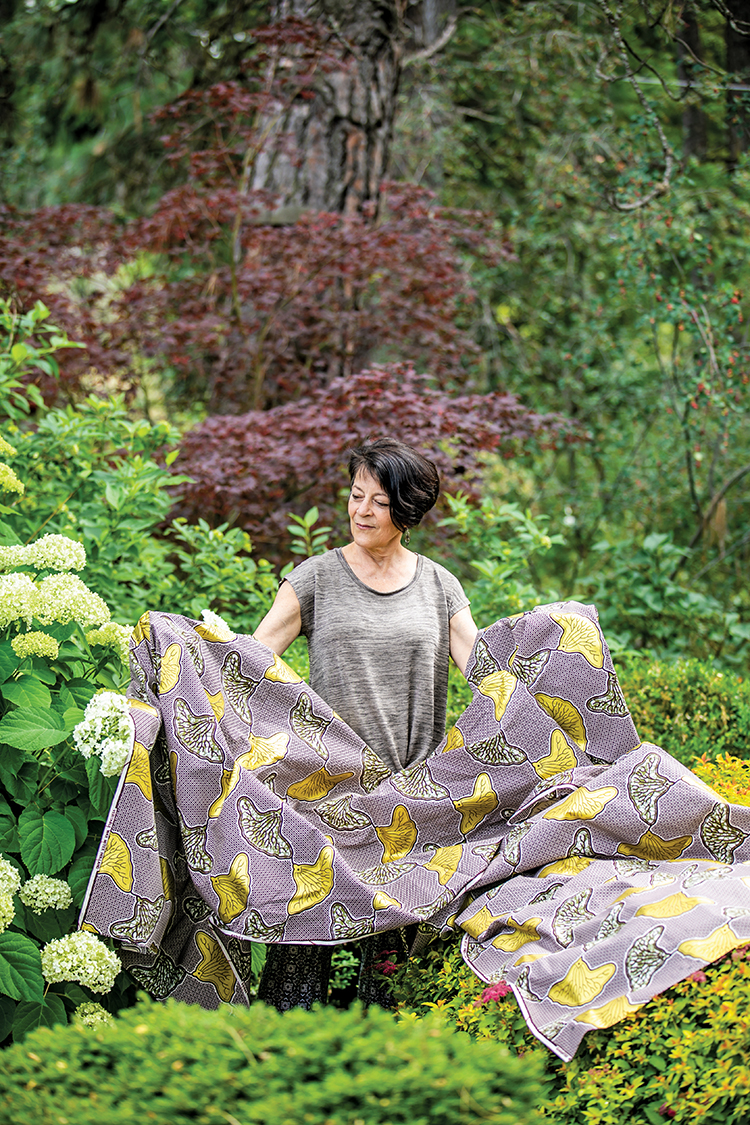
When my father died, I signed up for salsa lessons.
With his passing, I felt the urgency to live more fully. It was the finitude of life that finally opened me up to my real hunger — not just for beauty, but for a fuller, more generous engagement with the world. This was the beginning of my journey as a sewist of bold and provocative garments.
Mary Oliver’s question in the poem The Summer Day has guided me: “What will you do with your one wild and precious life?”
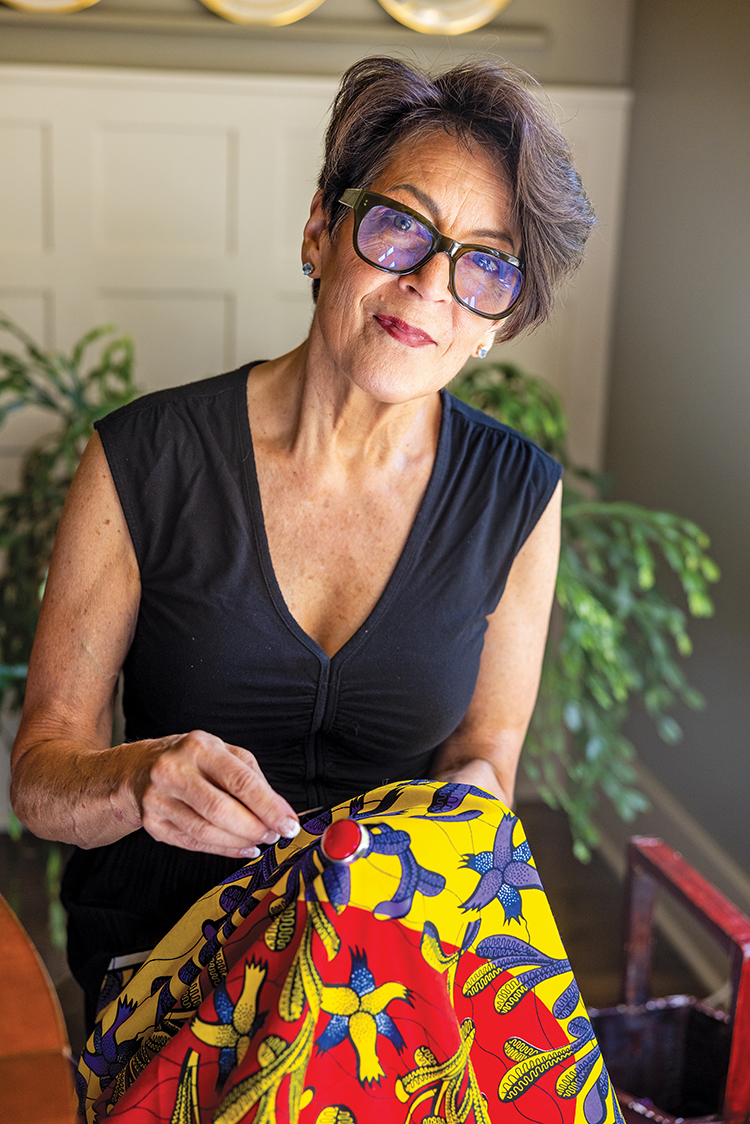
I found myself diving more deeply into my love of clothing design. It started when I developed a curiosity for the skirt I found in a thrift shop made from a bold geometric print with an unusual color combination. I came to discover it was one of the thousands of batik-like designs printed on machines invented in the 1800s by the Dutch — called Dutch wax prints — that have become culturally iconic in West Africa. I plunged into the world of African prints and a spark of inspiration grew into a transformative relationship with fashion and dressing.
My philosophy of wearing art did not come to me fully formed. My first Dutch wax creation — a tailored, princess-seam coat in a large border-to-border botanical print — was carefully planned with attention to matching the vining design at prominent seams and balancing the pattern over the length and circularity of the garment. Still one of my favorites, it was even more striking than I had hoped for, but hung in my closet waiting for my self-confidence to catch up to my imagination.
I finally stepped out, a frozen introvert inside a coat vibrating with color and pattern. Not only were conversations ignited at that concert I wore it to, but people remembered my coat months later. I began to see myself as someone who had something to offer, and to engage with strangers — dancers, artists, educators, entrepreneurs — and my world expanded. The unapologetic, explosive joy of Dutch wax prints has pushed me to be braver and more generous and has made me a believer that dressing boldly is like presenting yourself as a gift and extending an invitation to others to engage with curiosity and delight.
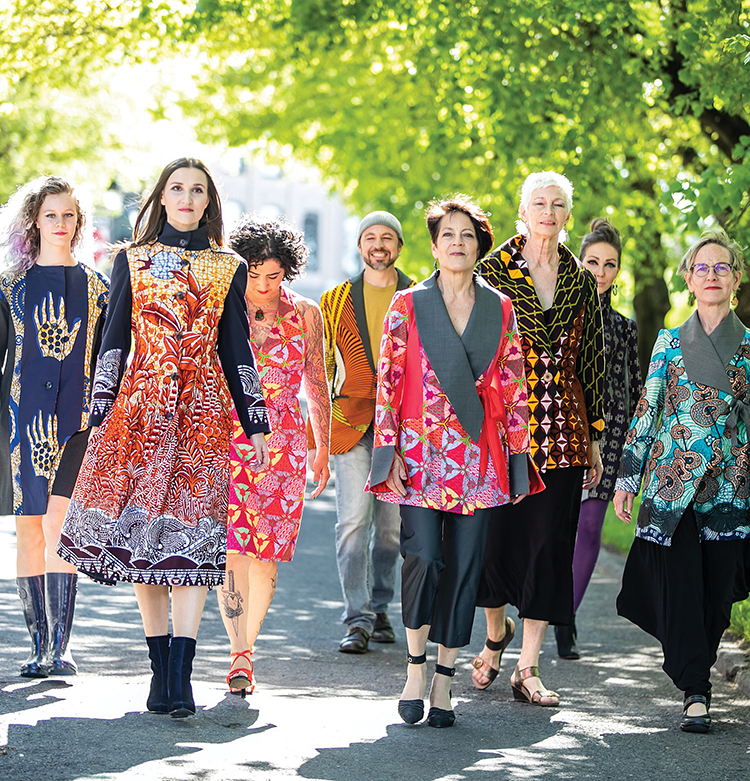
“AS LONG AS WE ARE ABLE TO BE EXTRAVAGANT WE WILL BE HUGELY AND DAMPLY EXTRAVAGANT.”
— Mary Oliver, When the Roses Speak, I Pay Attention
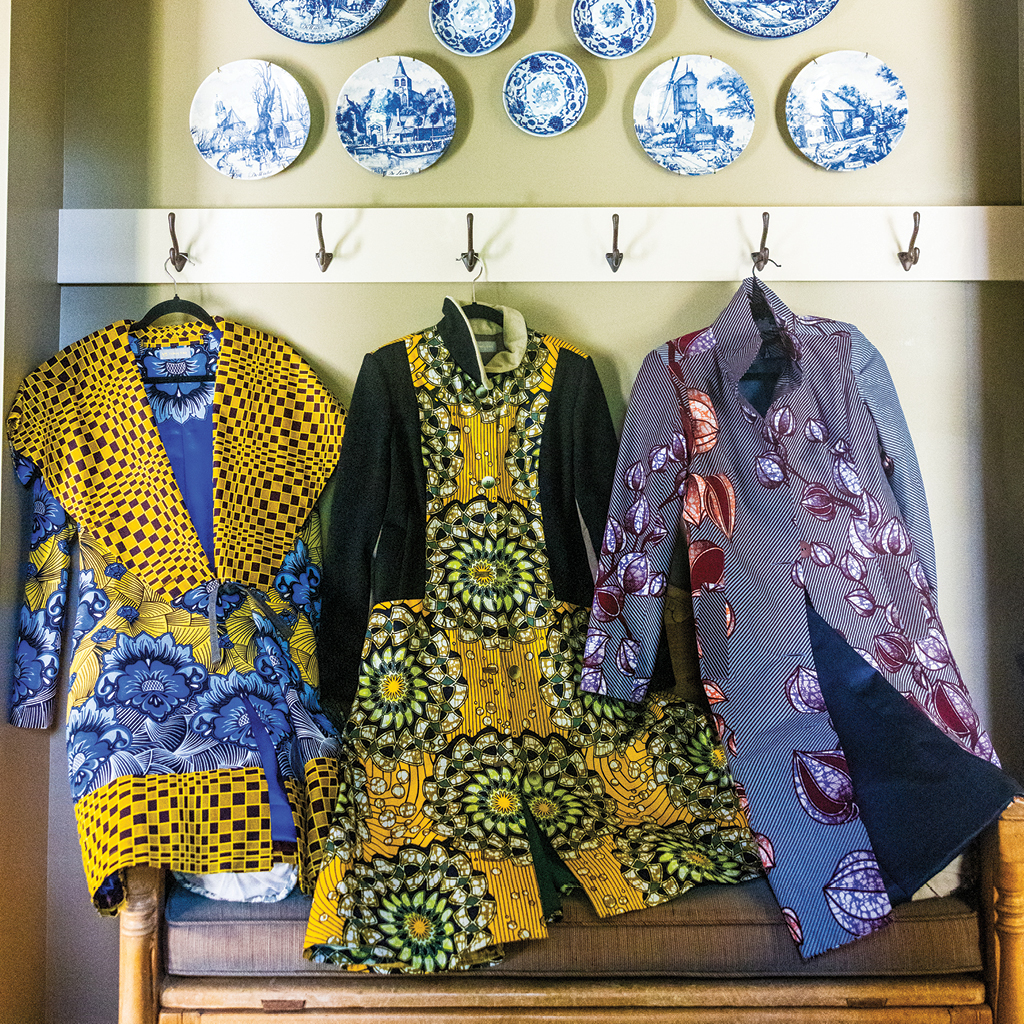
I wonder if my mother would have embraced her namesake, Francy King Wearable Art? Francy was a minister’s wife who filled a prescribed role, and I might be crossing her lines of modesty and decorum with my creations. But it was her creativity as a homemaker, especially her sewing skills, that put me on this path as a maker. I find myself, in art and in life, learning a complex dance between control and letting go, preserving and transformation.
My confidence and skill as a designer have grown, propelling me deeper into the playfulness and experimentation of creating. Along the way, one of my dad’s old suits presented itself to me as fabric I could use to “ground” colorful African prints and make them more connected to North American culture. Conservative men’s suiting was the ultimate judicious fabric and this combination of lightweight wools with bold print cottons turned out to be a very good match — in weight and drape, warmth added, and in aesthetic restraint.
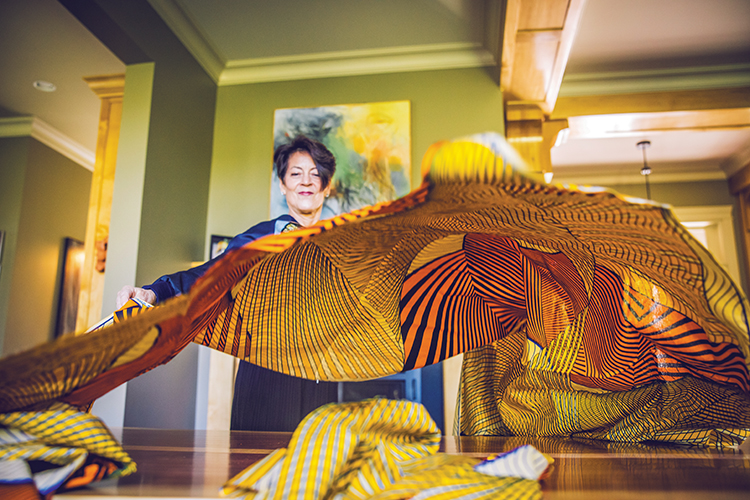
The process of “auditioning” fabrics to discover successful and synergistic combinations is my most demanding and creative task. It’s a term quilters use to choose the fabrics that will carry the design in a quilt.
I have been a landscape architect for several decades and am inspired by the dynamic mix of plant forms and textures in beautiful gardens. Combining prints and textures in fabrics is a similar design challenge.
I have a large collection of African prints to choose from, which is usually where I start in auditioning. My husband and I have prepared dozens of thrifted wool slacks — deconstructing, cleaning and pressing, and folding and stacking them in my dining room’s sideboard-turned-fabric- cabinet — ready for their audition. Finding a solid that enhances the print is just one of the roles to be filled. The interplay of textures — layering of sheer fabrics, piping, velvet collars, zippers and buttons — swirl around, switch places and come together in a sort of alchemy that surprises and transcends forethought.
Each garment I create is one of a kind. I buy only 6 yards of each print and every repurposed fabric is unique. I’ve collected patterns with pieces suitable for narrow widths of salvaged fabric, and for creating shape in the seaming, which is important when working with woven fabrics that do not stretch or conform to the body. I create some of my own patterns using a medium-weight clear vinyl that is durable and see-through for placing the print right where I want it on the garment.
Placing and cutting the fabric is a slow process, requiring concentration and many decisions. The whole process of designing and constructing Francy King garments is truly slow fashion: Each garment takes 20 to 30 hours.
Some of my favorite garment details include two-part sleeves (flattering and useful for narrow strips of wool), welt pockets (so clean and sharp) and bagged linings. I line all of my coats with a heavy satin that allows the coat to glide on over clothes, adds warmth and provides extra flow and body to the cotton. Often, I will choose a striking piece of the print and appliqué it to the lining in a place only the wearer will see. It’s a special affirmation for the wearer and preparation for the experience of wearing the art.
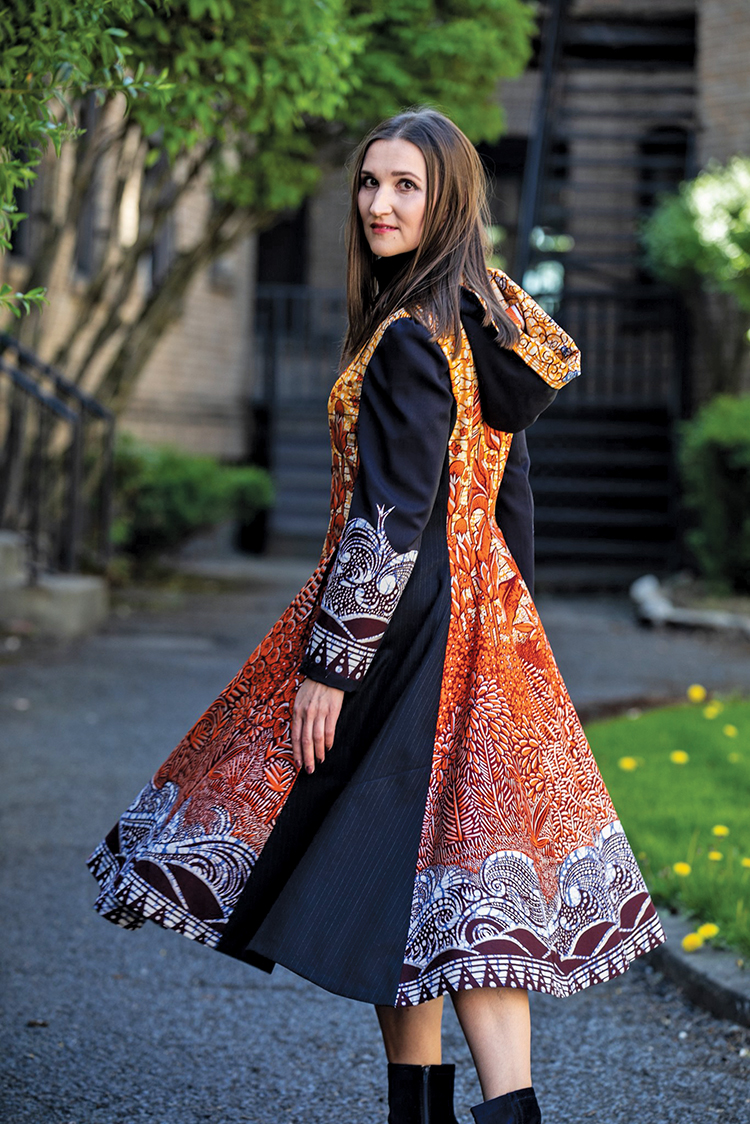
Pockets are a detail that I love to use liberally. Pockets add great utility to clothing and are why men don’t carry purses! I’ve mentioned welt pockets, but I also love to hide pockets in seams, create zippered pockets and sew interior pockets into linings. I’ve even put a pocket in a sleeve. I also reuse pockets from my repurposed items, such as patch pockets on jeans, buttoned hip pockets on men’s slacks and fancy welt pockets on women’s wool skirts. Pockets are power!
My longer coats are often fit-and-flare shapes with full, extravagant skirts. I make a 12-gore coat, with pieces that taper to just a few inches at the waist, that takes the full 6 yards of the print plus several pairs of wool pants to construct. These long coats are perfect for transitional times of cooler weather, and they are unforgettable statement pieces for special occasions like holiday parties or milestone celebrations. My dream is to make a wedding coatdress someday for a bold bride out of vibrant Dutch wax!
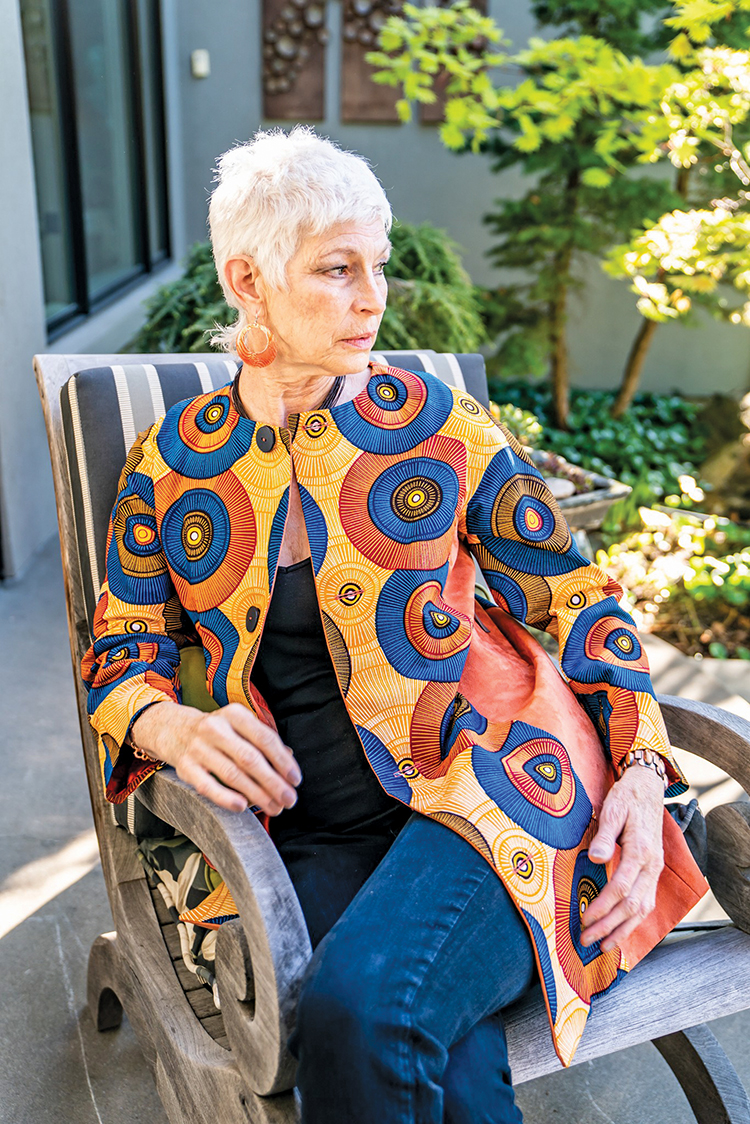
Shorter Francy King coats can be dressed up or down and their use is only limited by the imagination and personality of the wearer. One of my most popular styles is a unisex bomber jacket. I’ve made these in several sizes with botanical or geometric prints combined with lace and wool. Chunky zippers and front and inside pockets add casual comfort and utility. I don’t presuppose anymore which bomber jacket will appeal to whom and it puts a smile on my face to see men, especially, stepping out of safe choices into a Francy King.
I think the juxtaposition of unexpected materials is one of the most distinctive qualities of my art. There is the surprise of unusual designs and colors, but also the contrast in character of new and old fabrics and the cultural shift of a print designed for women in West Africa made into a garment for the climate and mien of North America. On a more personal level, I love being able to explore and articulate the balance between my fashion flights of fancy and my mother’s grounded restraint.
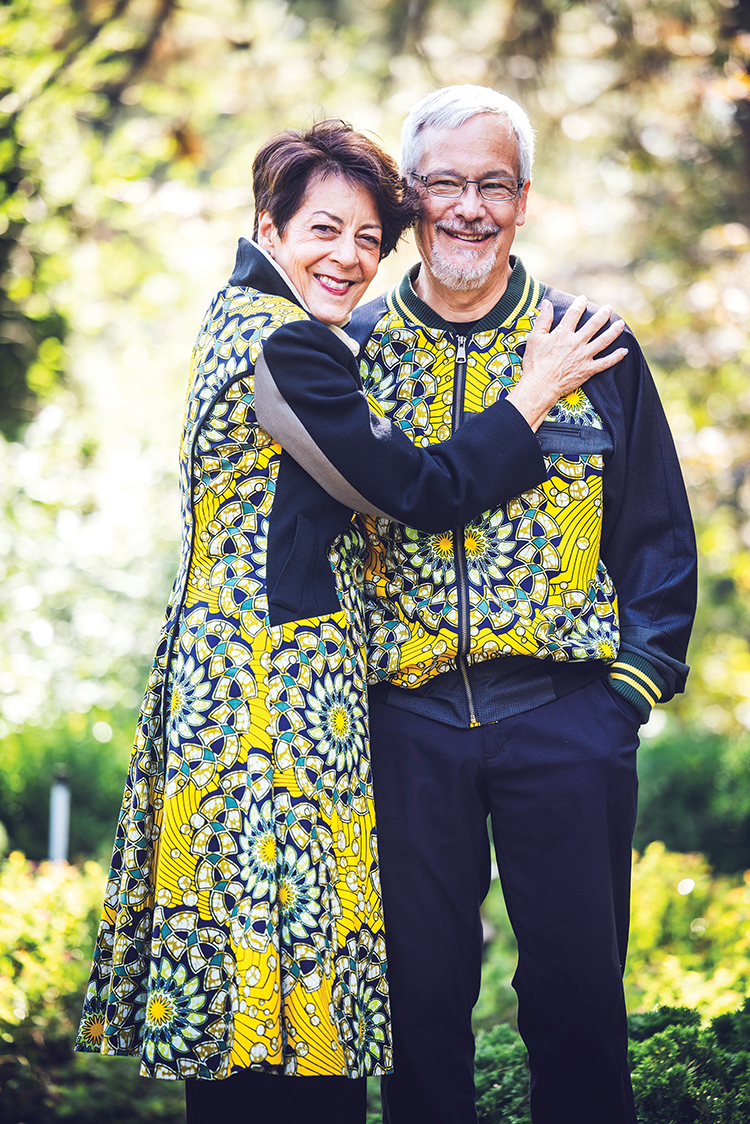
Contrast creates focus and helps people to see things in a new way or more clearly, as they really are. I hope my garments will do that: break down stereotypes, invite conversation, inspire risk-taking and open people up to living more generously.
I have found creating and wearing joyful art to be a fertile place in my life for expanding community. Engaging friendships begin with small things — a look, a smile, a conversation, curiosity and caring interest in others — and one of my favorite ways to set things in motion is with a bold, provocative coat.

When my father died, I signed up for salsa lessons.
With his passing, I felt the urgency to live more fully. It was the finitude of life that finally opened me up to my real hunger — not just for beauty, but for a fuller, more generous engagement with the world. This was the beginning of my journey as a sewist of bold and provocative garments.
Mary Oliver’s question in the poem The Summer Day has guided me: “What will you do with your one wild and precious life?”

I found myself diving more deeply into my love of clothing design. It started when I developed a curiosity for the skirt I found in a thrift shop made from a bold geometric print with an unusual color combination. I came to discover it was one of the thousands of batik-like designs printed on machines invented in the 1800s by the Dutch — called Dutch wax prints — that have become culturally iconic in West Africa. I plunged into the world of African prints and a spark of inspiration grew into a transformative relationship with fashion and dressing.
My philosophy of wearing art did not come to me fully formed. My first Dutch wax creation — a tailored, princess-seam coat in a large border-to-border botanical print — was carefully planned with attention to matching the vining design at prominent seams and balancing the pattern over the length and circularity of the garment. Still one of my favorites, it was even more striking than I had hoped for, but hung in my closet waiting for my self-confidence to catch up to my imagination.
I finally stepped out, a frozen introvert inside a coat vibrating with color and pattern. Not only were conversations ignited at that concert I wore it to, but people remembered my coat months later. I began to see myself as someone who had something to offer, and to engage with strangers — dancers, artists, educators, entrepreneurs — and my world expanded. The unapologetic, explosive joy of Dutch wax prints has pushed me to be braver and more generous and has made me a believer that dressing boldly is like presenting yourself as a gift and extending an invitation to others to engage with curiosity and delight.

“AS LONG AS WE ARE ABLE TO BE EXTRAVAGANT WE WILL BE HUGELY AND DAMPLY EXTRAVAGANT.”
— Mary Oliver, When the Roses Speak, I Pay Attention

I wonder if my mother would have embraced her namesake, Francy King Wearable Art? Francy was a minister’s wife who filled a prescribed role, and I might be crossing her lines of modesty and decorum with my creations. But it was her creativity as a homemaker, especially her sewing skills, that put me on this path as a maker. I find myself, in art and in life, learning a complex dance between control and letting go, preserving and transformation.
My confidence and skill as a designer have grown, propelling me deeper into the playfulness and experimentation of creating. Along the way, one of my dad’s old suits presented itself to me as fabric I could use to “ground” colorful African prints and make them more connected to North American culture. Conservative men’s suiting was the ultimate judicious fabric and this combination of lightweight wools with bold print cottons turned out to be a very good match — in weight and drape, warmth added, and in aesthetic restraint.

The process of “auditioning” fabrics to discover successful and synergistic combinations is my most demanding and creative task. It’s a term quilters use to choose the fabrics that will carry the design in a quilt.
I have been a landscape architect for several decades and am inspired by the dynamic mix of plant forms and textures in beautiful gardens. Combining prints and textures in fabrics is a similar design challenge.
I have a large collection of African prints to choose from, which is usually where I start in auditioning. My husband and I have prepared dozens of thrifted wool slacks — deconstructing, cleaning and pressing, and folding and stacking them in my dining room’s sideboard-turned-fabric- cabinet — ready for their audition. Finding a solid that enhances the print is just one of the roles to be filled. The interplay of textures — layering of sheer fabrics, piping, velvet collars, zippers and buttons — swirl around, switch places and come together in a sort of alchemy that surprises and transcends forethought.
Each garment I create is one of a kind. I buy only 6 yards of each print and every repurposed fabric is unique. I’ve collected patterns with pieces suitable for narrow widths of salvaged fabric, and for creating shape in the seaming, which is important when working with woven fabrics that do not stretch or conform to the body. I create some of my own patterns using a medium-weight clear vinyl that is durable and see-through for placing the print right where I want it on the garment.
Placing and cutting the fabric is a slow process, requiring concentration and many decisions. The whole process of designing and constructing Francy King garments is truly slow fashion: Each garment takes 20 to 30 hours.
Some of my favorite garment details include two-part sleeves (flattering and useful for narrow strips of wool), welt pockets (so clean and sharp) and bagged linings. I line all of my coats with a heavy satin that allows the coat to glide on over clothes, adds warmth and provides extra flow and body to the cotton. Often, I will choose a striking piece of the print and appliqué it to the lining in a place only the wearer will see. It’s a special affirmation for the wearer and preparation for the experience of wearing the art.

Pockets are a detail that I love to use liberally. Pockets add great utility to clothing and are why men don’t carry purses! I’ve mentioned welt pockets, but I also love to hide pockets in seams, create zippered pockets and sew interior pockets into linings. I’ve even put a pocket in a sleeve. I also reuse pockets from my repurposed items, such as patch pockets on jeans, buttoned hip pockets on men’s slacks and fancy welt pockets on women’s wool skirts. Pockets are power!
My longer coats are often fit-and-flare shapes with full, extravagant skirts. I make a 12-gore coat, with pieces that taper to just a few inches at the waist, that takes the full 6 yards of the print plus several pairs of wool pants to construct. These long coats are perfect for transitional times of cooler weather, and they are unforgettable statement pieces for special occasions like holiday parties or milestone celebrations. My dream is to make a wedding coatdress someday for a bold bride out of vibrant Dutch wax!

Shorter Francy King coats can be dressed up or down and their use is only limited by the imagination and personality of the wearer. One of my most popular styles is a unisex bomber jacket. I’ve made these in several sizes with botanical or geometric prints combined with lace and wool. Chunky zippers and front and inside pockets add casual comfort and utility. I don’t presuppose anymore which bomber jacket will appeal to whom and it puts a smile on my face to see men, especially, stepping out of safe choices into a Francy King.
I think the juxtaposition of unexpected materials is one of the most distinctive qualities of my art. There is the surprise of unusual designs and colors, but also the contrast in character of new and old fabrics and the cultural shift of a print designed for women in West Africa made into a garment for the climate and mien of North America. On a more personal level, I love being able to explore and articulate the balance between my fashion flights of fancy and my mother’s grounded restraint.

Contrast creates focus and helps people to see things in a new way or more clearly, as they really are. I hope my garments will do that: break down stereotypes, invite conversation, inspire risk-taking and open people up to living more generously.
I have found creating and wearing joyful art to be a fertile place in my life for expanding community. Engaging friendships begin with small things — a look, a smile, a conversation, curiosity and caring interest in others — and one of my favorite ways to set things in motion is with a bold, provocative coat.









